Lara Croft and the Tomb Raider franchise has more than simply evolved through the years. Croft has become more than a nice physique and a game developer’s dream girl. The franchise, too, has outlasted its competitors with a stream of games releasing for more than two decades. Shadow of the Tomb Raider is the latest in a long line of Tomb Raider titles, and it could possibly be the most narratively deep one to date.
During E3 2018, I was privy to an early build of Croft’s latest adventure in the NVIDIA booth. There was a reintroduction to her climbing abilities, a puzzle tomb, and a sliver of combat. Oh, and a kid died (not in real life, only in the demo). I couldn’t help shake a feeling of unreadiness surrounding it.
Don’t go breakin’ my heart
After I had left my hands-on appointment, I was honestly a bit worried about the game. Nothing really leaped out at me other than Croft’s new abilities to stealthily hide in walls and cover herself in mud. I did like the Arnold-Schwarzenegger-in-“Predator” feel it created, harking back to many Hollywood popcorn action flicks. There wasn’t a cloud of hype swirling above me like the most recent two installments in the franchise created. Maybe I was becoming tired of the rebooted series, though it was more than merely a facelift and a new coat of paint. I found it to be a necessary tale of Croft’s beginnings, peeling back the curtain on how she became a hardened explorer.
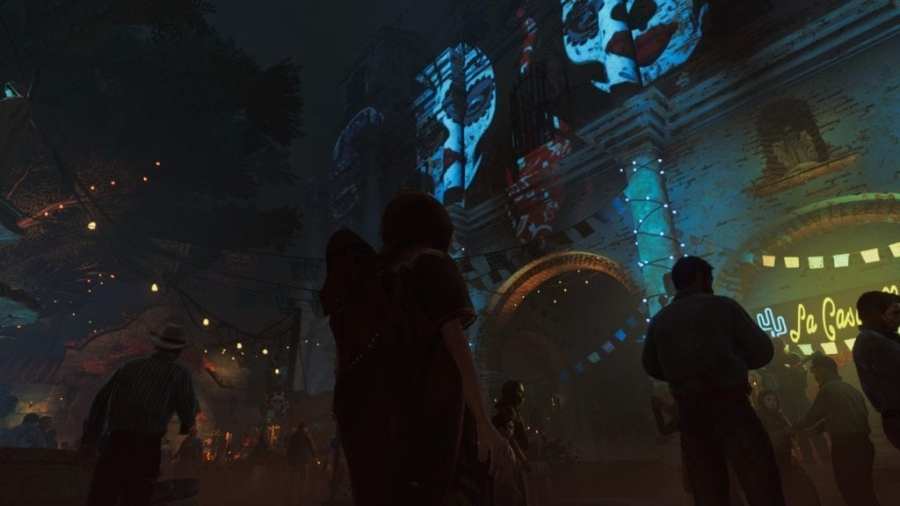
Early portions of the game set the tone in terms of environmental polish and immersion.
Tomb Raider (2013) was the first game in the series’ reboot. There’s no doubt that it was one of my favorite games released that year, which also happened to accompany my PC gaming revival. I couldn’t help but want to play the game on my rig at the time. As the years went on, so did my hobby of making tweaks here and there and building another gaming PC. My fanship for the franchise was already cemented by the time Shadow of the Tomb Raider started to rear its head.
Act I: Scenery I
I recently went back and played a few portions of Rise of the Tomb Raider mostly to jog my memory glands. One thing that was very apparent is the sheer scale that the game embraced. City ruins could be marveled at from the distance, while sweat-inducing climbs drummed up my inner fear of heights. To counter this, Shadow of the Tomb Raider creates that same tension but with a sense of constriction. Underwater moments turned vicious as Lara squeezed through rock openings, and the same can be said about the tombs discovered in small cavities of rock.
This time around, though, the giant ancient civilizations aren’t just to provide a backdrop in a scene. They are instead very much a part of the game’s design in bringing a more open-world experience feel.
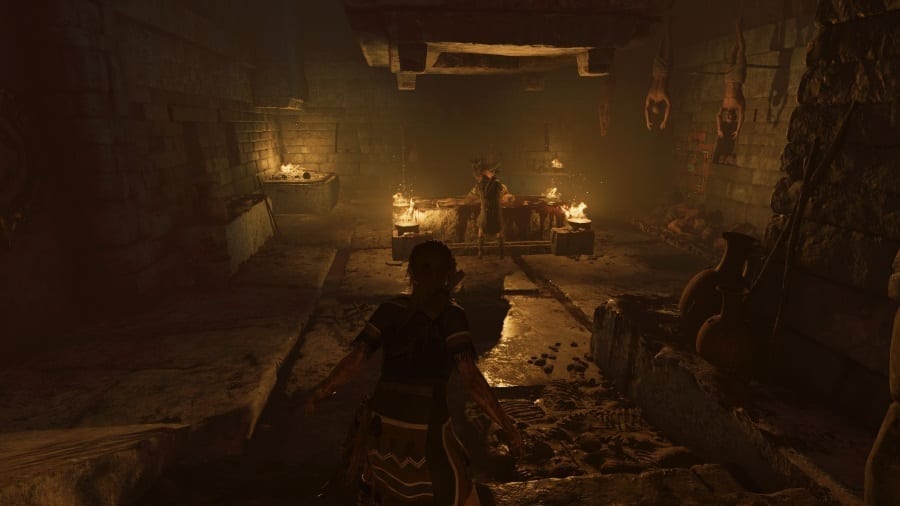
There is a much more violent, darker overall theme throughout the game.
The vast majority of the game is a nothing short of a spectacle. There’s a simplistic yet rich color palette used throughout the game; jungle settings feel dense and daunting; early market scenes set the tone for what you can expect for the rest of your experience. I’ve avoided some of the major plot points to the story in order to keep spoilers to the bare minimum. You should know that the organization that the organization known as Trinity is still nipping at Lara’s heels and a lot is revealed as the curtain draws.
After I had finished the game, I could only imagine the conversations surrounding its development. The ambitious level design and pockets of open areas of exploration provide a solid breadth of content. It’s almost overwhelming at first. But, when the game does start to gain its footing (and a long introduction of moves and crafting abilities in your skillset), it’s hard not to appreciate how side quests and challenge tombs shape the world. Many of these can be discovered simply through exploring the outskirts of each map or jumping into what might appear to be a shallow watering hole. The complex dialogue and character models are proof that the team was striving for an immersive narrative experience that was lined with combat and exploration.
Forced perspective
If you were to look at the main difference between Shadow of the Tomb Raider and its predecessors, there is a noticeable change in the focus of the core gameplay. The first two titles centered on crafting and prominent amount of combat. The emphasis in battles slightly shifts as Shadow of the Tomb Raider shackles you to stealth and bow tactics, often removing guns altogether from the environment.
The change feels necessary. Enemies by majority wield blades or bows. However, there are crucial moments where you let the pistol do the talking — those moments are fairly sparse. You could have easily taken all guns and heavy weaponry out without disrupting the core feel of the game. It does, however, showcase an important feature created within the confines of Tomb Raider.
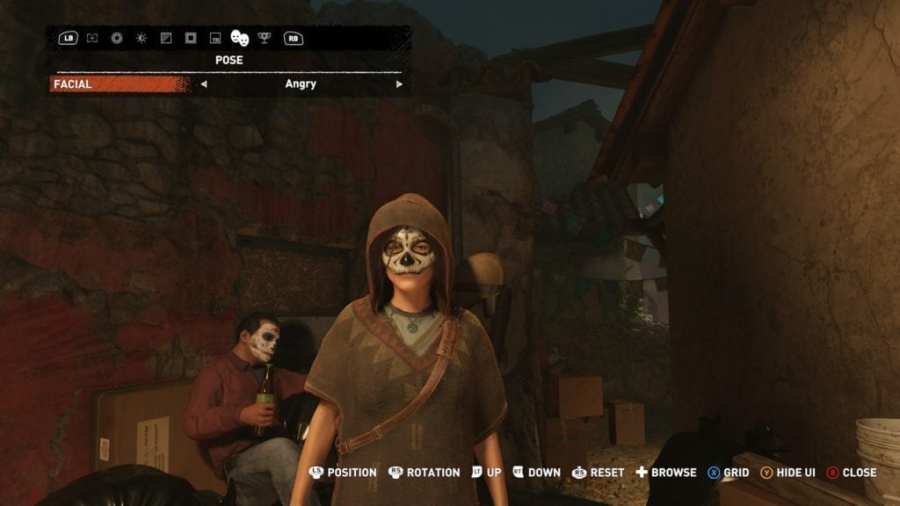
There’s a number of features within the photo mode. You can even change Lara’s expression or add filters to any scene.
The majority of the in-game areas are found in remote locations, hidden from the outside world. These are civilizations encapsulated in primitive times. For example, when running the streets of Paititi, I often forgot I was playing a Tomb Raider game set in a modern era. As Lara dons a tunic, wrapped sandals, or other authentic garbs, she too embraces the culture.
The newly introduced photo mode allows you to fully capture your experience. Tilt, zoom or filter your shots, even manipulating Lara’s facial expressions. I can’t tell you how many times I was side-tracked manipulating my current jaunt through Croft’s world.
Just skillin’ it
As previously mentioned, there isn’t so much focus on combat as in prior games. A lot more time is spent picking up additional items to craft or improve weapons. It seemed there were far more campsites to discover, each of which can be used to improve abilities as well as fast-travel points. Having more of these allows equipment and skill upgrades to occur far more often. I did find myself caring less about what skills I unlocked, almost making them arbitrary. There was never a nagging feeling to build out my skill tree in order to progress the story. Even though robust (similar to what you might see in recent Far Cry games) there was no real sense of urgency unlocking new skill tiles, especially ones involving combat.
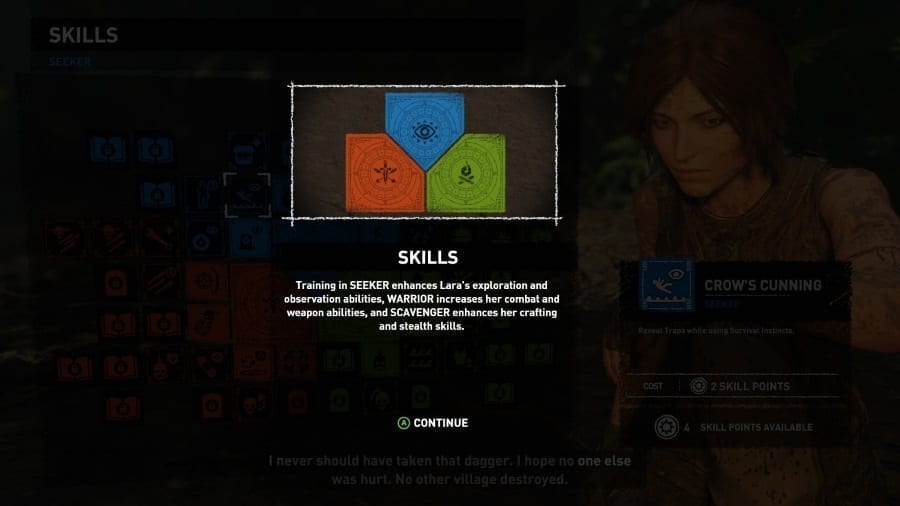
Each tile represents a different area of skills to unlock.
Outside of combat, there is an exceptional amount of content to unearth. I finished the story first mostly for review purposes — this alone took me around 15 hours. I did some side-quests during my playthrough, stopping way too often read monoliths and other descriptive architecture. By default, I am definitely not this type of gamer. My attention span only allows for so much bandwidth. But for some reason in playing the recent run of Tomb Raider games, I become Indiana Greg.
Rappelling into encased tombs with small shrines never gets old to me, and they stand as one of my favorite aspects of the game. Although it was disappointing to not observe artifacts early on due to a bug within the game, there’s still a lot to discover as I’m still hovering around the 60 percent mark in completion.
Catch ‘ya later, Croft
If Shadow of the Tomb Raider is the last installment in the line of Tomb Raider reboots, I’d be fairly happy where the story leaves off. There were moments of heavy hitting emotion, often leading to wonderment and intrigue as to what was going to happen next. This was the first game in a long time that I was in it for the long haul. After the conclusions of each portion of the story, I would always think, “What’s next?” I had more moments of wanting to turn to the next page than setting it down to only come back to it at a later time.
Eidos-Montréal delivered on deep narrative sendoff for Lara Croft. Although there is an apparent focus on exploration, conversation, and discovery, it only detracts from what the franchise has so heavily focused on in years past in order to create a story-driven farewell for the time being. Less time spent shooting, killing, and looting isn’t necessarily a bad thing; the franchise has adapted and evolved throughout the years, and Shadow of the Tomb Raider showcases that maturation.
Until next time, Ms. Croft.
Editor’s note: During my playthrough, I did encounter a few problems that pertained to the graphics settings of the game. We contacted Square Enix regarding texture pop-in during cinematics, reticule and artifacts disappearing in-game. Making adjustments to the anti-aliasing resolved those issues. We were also informed that a Day 1 patch is also planned for Shadow of the Tomb Raider.
Review code was provided by Square Enix.

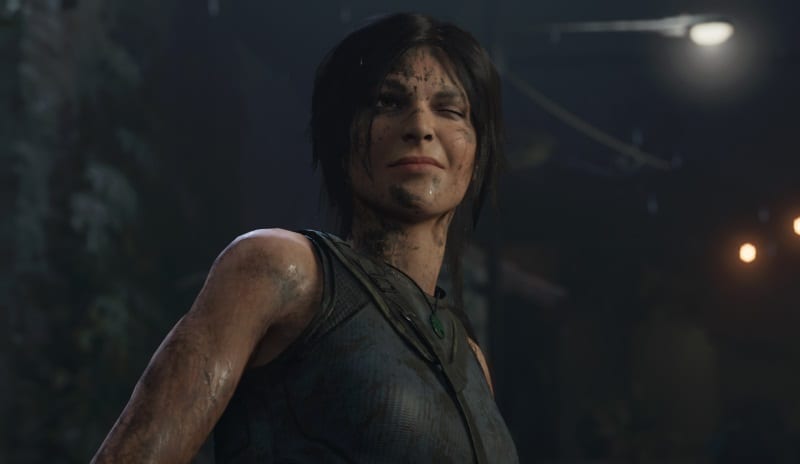





Published: Sep 10, 2018 09:00 am